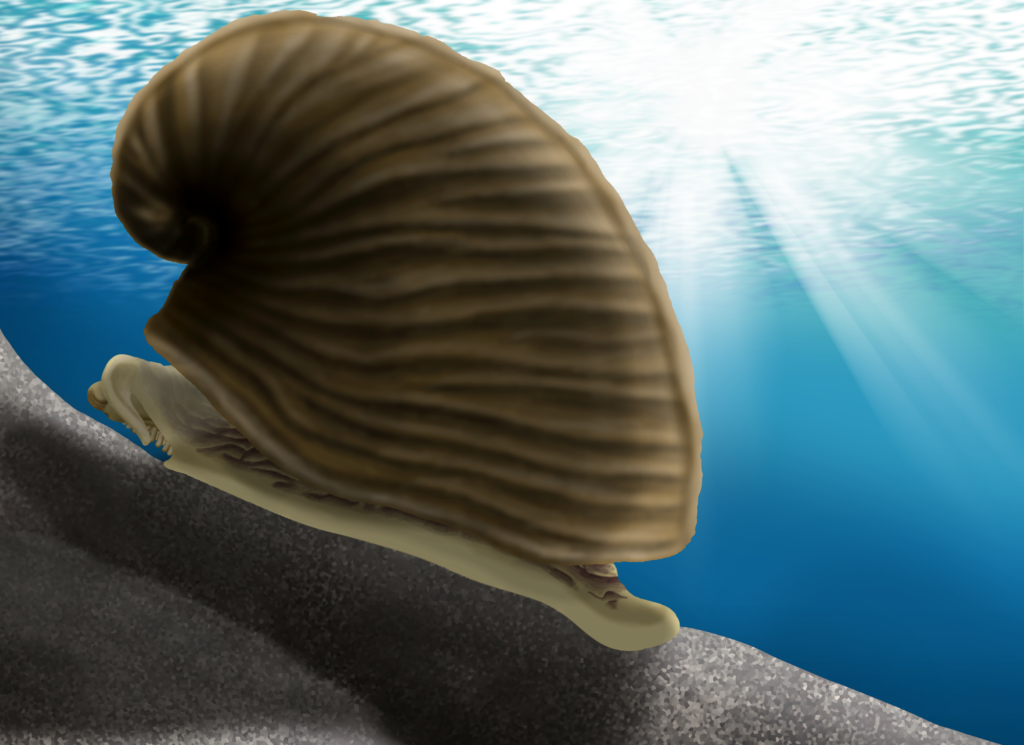
Monoplacophora is a little known molluscan group that is represented by one species at Seven Stars. They have traditionally been viewed as the original stem mollusk, as they are among the first undoubted mollusk fossils to be found in the Cambrian. They are still alive today, but unlike many fossil forms, inhabit deeper waters that make observation difficult (1)
Brachiopods found at Seven Stars
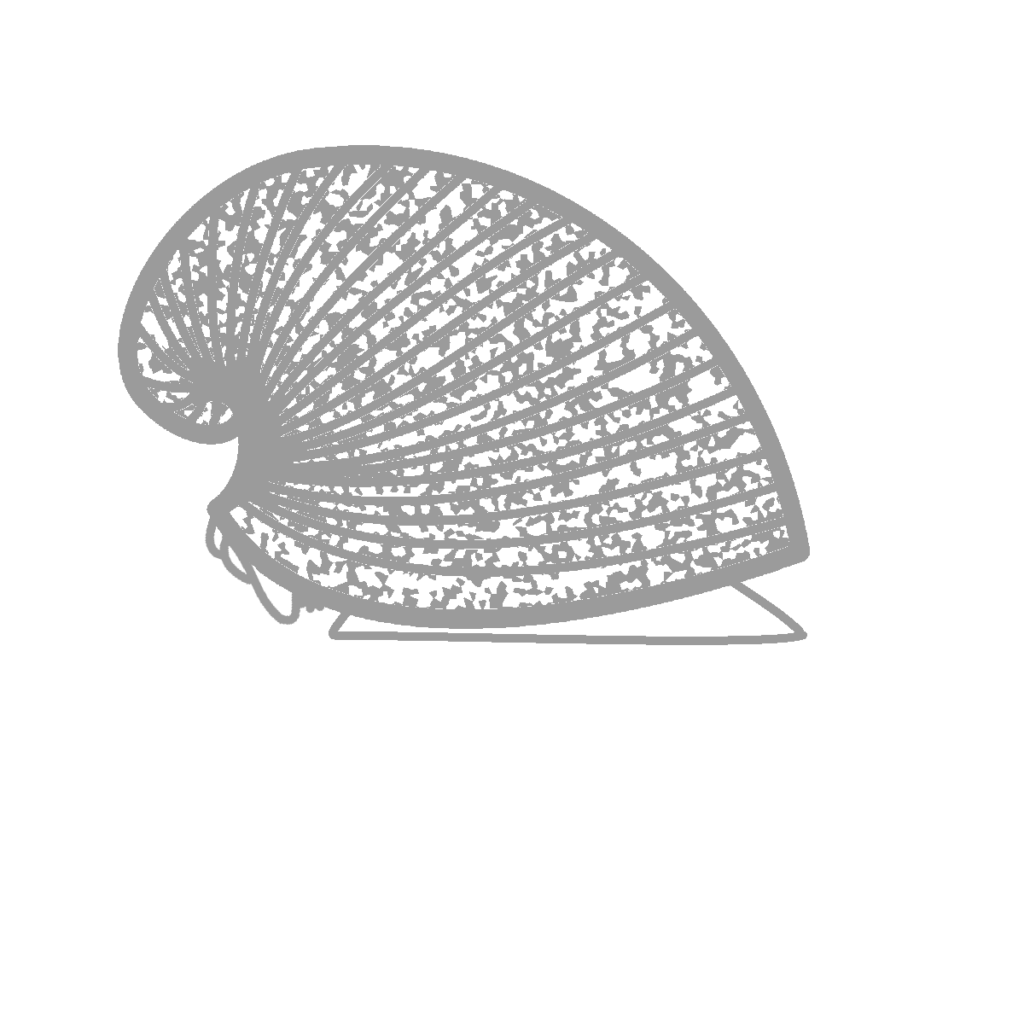
Cyrtonella mitella
RARE
How do I identify Monoplacophorans?
For a while, the only Monoplacophoran from Seven Stars, Cyrtonella mitella, was mistaken for the Gastropod Crenistriella crenistria, which appears to be the original name, when this mollusk was classified as a Gastropod. In fact, some collectors still use this name and classification.
Cyrtonella can be classified as a Monoplacophoran because of its muscle scars and its shell structure (see A Note on Bellerophont relations) (2). All Monoplacophorans have radially arranged muscle scars that help it pull its large, round foot into its shell, as well as helping the Monoplacophoran crawl around (1).
A number of fossil Monoplacophorans, which seem to have had much more variability in habitat choice, have been preserved with large, polygonal crystals as the main components of their shells. These have been interpreted as both artifacts of shell preservation and as what they first appear to be. Similar structures have been observed in modern Bivalves, and have a scaled-up prismatic structure that has been hypothesized to have increased shell flexibility. This makes sense, as the large prismatic crystals are usually confined to the apertural region of the shell, where extra flexibility would be most beneficial to the animal. Later authors reported similar shell structure in modern Monoplacophorans, and coined the term foliated argonite to describe its large crystal structure, which was not exposed but covered by an external periostracum and an internal more foliated finish.
At least one author noticed this same structure appearing in both Cyrtonella and the large Seven Stars Bellerophontid Gastropod, Ptomatis patulus, again in the apertural region (2), but not as prominent as in Cyrtonella. While usually these are weathered off of fossils from Seven Stars, they are present and can be used as a way to recognise Monoplacophorans.
Specifically, Cyrtonella can be differentiated from Gastropods at the site because of its rough growth lines that seemingly lack a recognizable pattern. All Gastropods from Seven Stars have growth lines or other ornamentation organized into predictable patterns that are easy to tell apart. Cyrtonella also possesses a rounded keel on the anterodorsal edge of its shell, which curves quite rapidly, unlike the winding whorls of Gastropods.
What were Monoplacophorans?
Monoplacophorans are an enigmatic group of mollusks that share a loose resemblance to Patellogastropods, which were related to the Seven Stars Gastropod Cyclonema. Modern Monoplacophorans, as mentioned above, are mostly restricted to the deep sea, where they are sometimes dragged up for study. With low, pointed, exograstric (forward-pointing) shells, they seem in numerous ways different from fossil Monoplacophorans, which seem to be polyphyletic as a result of many groups being assigned to it on the basis of its vague defining characteristics that seem more common than originally guessed (4).
While modern Monoplacophorans are usually smaller than 1 cm, through the Devonian (when they were once thought to have gone extinct) they reached much larger sizes. Cyrtonella grows to roughly 2 cm tall; some other Paleozoic forms could grow to 5 cm (4).
All Monoplacophorans have a large, semicircular foot that is connected to the head. The head cannot move apart from the foot; it is mainly composed of the oral structure explained below. The musculature of the foot is concentrated in the outer edge, the center being very weakly muscularized. Fossil Monoplacophorans had eight retractor muscles; each was anchored directly to the shell, focused on a single point. Modern Monoplacophorans have different musculature, but their muscles can be traced to the muscles of fossil forms. Each muscle scar anchored two branches of muscles, one running to the center of the foot and one running to the outer rim.
Monoplacophorans have anterior muscles that mainly control the oral appendages; some Paleozoic examples have large muscle scars in these areas and therefore likely possessed more muscularized heads than modern Monoplacophorans (4).
Fossil Monoplacophorans are thought to have grazed on mats of algae and bacteria; there is no evidence of these at Seven Stars. Modern species feed on detritus and other food that builds up on the seafloor; it is not known whether they possess chemical sensing or visual organs, or neither.
The mouth in modern Monoplacophorans is associated with many muscles, and has two “lips”. The anterior lip bears two large, flattened tentacles, called velum. The second posterior lip bears many to few tentacles, depending on the species in question, called post-oral tentacles (see Figure 1, below)(4). The two lips are covered in cilia, which help to push food towards the mouth, which bears a radula (3). In front of and slightly below the radula is a hardened jaw (4).
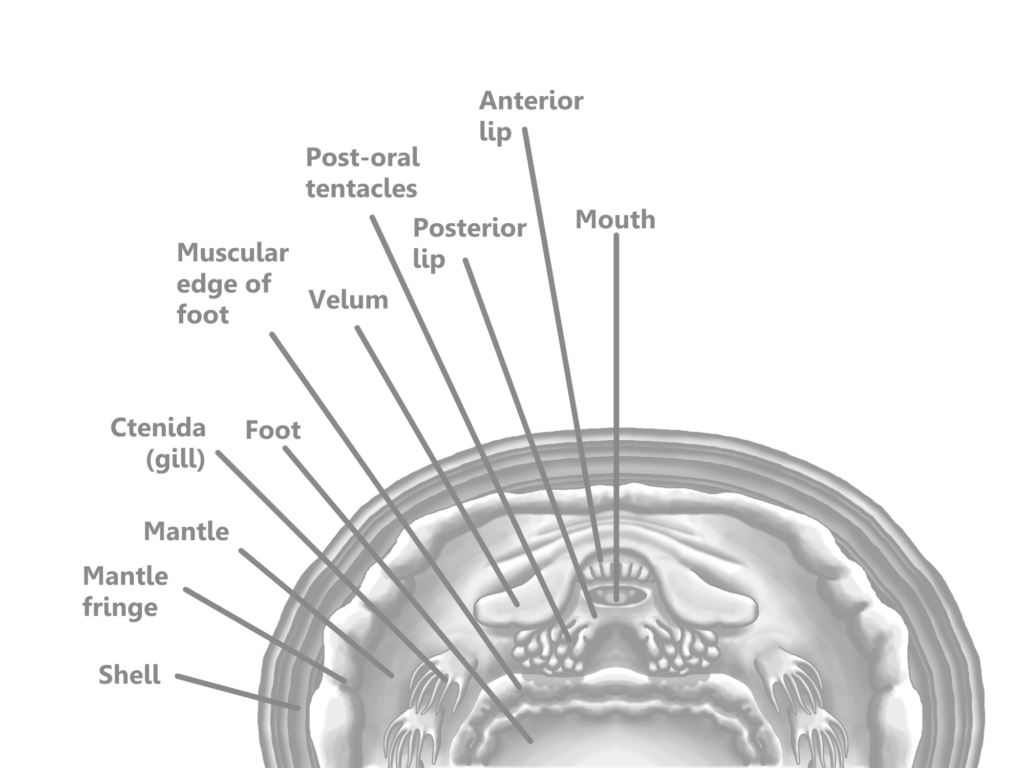
The digestive system of Monoplacophora has various parts. The esophagus has three regions; the first is simple and grooved; the second is lined by two pouches, and the third leads to the triangular stomach. The intestine is long and loops back on itself six times to the left; the anus is located on a short posterior tube in the mantle cavity..
The foot is an extension of the mantle, a fleshy tissue that all mollusks have. In most groups, it is used to excrete the shell material dorsally; More ventral portions serve as a means of locomotion. In the cavity between the pedal mantle and the dorsal mantle, Monoplacophorans usually have 5-6 pairs of muscular gills that constantly beat to generate a flow of water from which to breathe (3). It is thought that the kidneys, which are closely associated in position and number to the gills, may contribute more to respiration than the gills do (3); they are connected to more arteries (4), and are exposed (3).
Monoplacophorans have reacted similarly to Patellogastropods when it comes to defense; bright, warm lights triggered a raising of the body and shell, orienting it forward, while the gills beat with more power than usual (4). Seeing as modern monoplacophorans live in the deep sea, they likely have very different behaviors in comparison to their more shallow water Paleozoic relatives.
A Note on Bellerophont Relations
A very lively argument between paleontologists has occurred since the mid 1900s. The group in question, Bellerophontida, has been inserted into both Tergomya (true Monoplacophora) and Gastropoda. Proponents of Bellerophontiform mollusks being placed within Tergomya cite both bilateral posterior muscle scars, which would suggest a lack in Gastropod torsion (5), and the presence of umbilico-lateral sinuses (anterior sinuses in the shell for inhaling seawater), for the same reason (7). Dzik (1980) put together a phylogeny of numerous Bellerophontiforms, including Cyrtonella, as an oddity within Cyrtonellida(6). Proponents of Bellerophontiform mollusks being placed within Gastropods cite un-segmented umbilical scars being found on some Bellerophontiforms, as evidence of re-organization of internal organs due to torsion.
This resulted in two views:
- Both Monoplacophorans and Gastropods were Bellerophontiforms in form but were not related, or
- Gastropods arose from Bellerophontiforms, which also included Monoplacophora.
Other authors suggested different ideas, for instance that Bellerophontiforms are not closely related to Gastropoda and that their muscle configuration helped them hide in their shell, or that they were simply Gastropods that had already gone through torsion; adult muscles were different from larval ones.
Still other authors, observing both the Proto- and Teleochonchs of some Bellerophontiforms, found them to be very similar to Vetigastropods. Others, including the Cyrtonellids, had a different type, suggesting that the Bellerophontiforms were two separated groups. Some authors claimed that one of these were Tergomyans, while others were related to Vetigastropods, and other authors claimed that both were contained within Gastropoda (5). One of these, Wagner (2001), also referenced Cyrtonella itself as a Tergomyan, only adding to the uncertainty concerning this species (8).
In summary, it is unclear whether the Bellerophonts, and possibly Cyrtonella, are Terygomyan Monoplacophorans or Gastropods of some type or another. It seems likely that Bellerophontida is paraphyletic, and it is possible that both resulting groups are Gastropods, while Cyrtonella is not, instead being a Tergomyan.
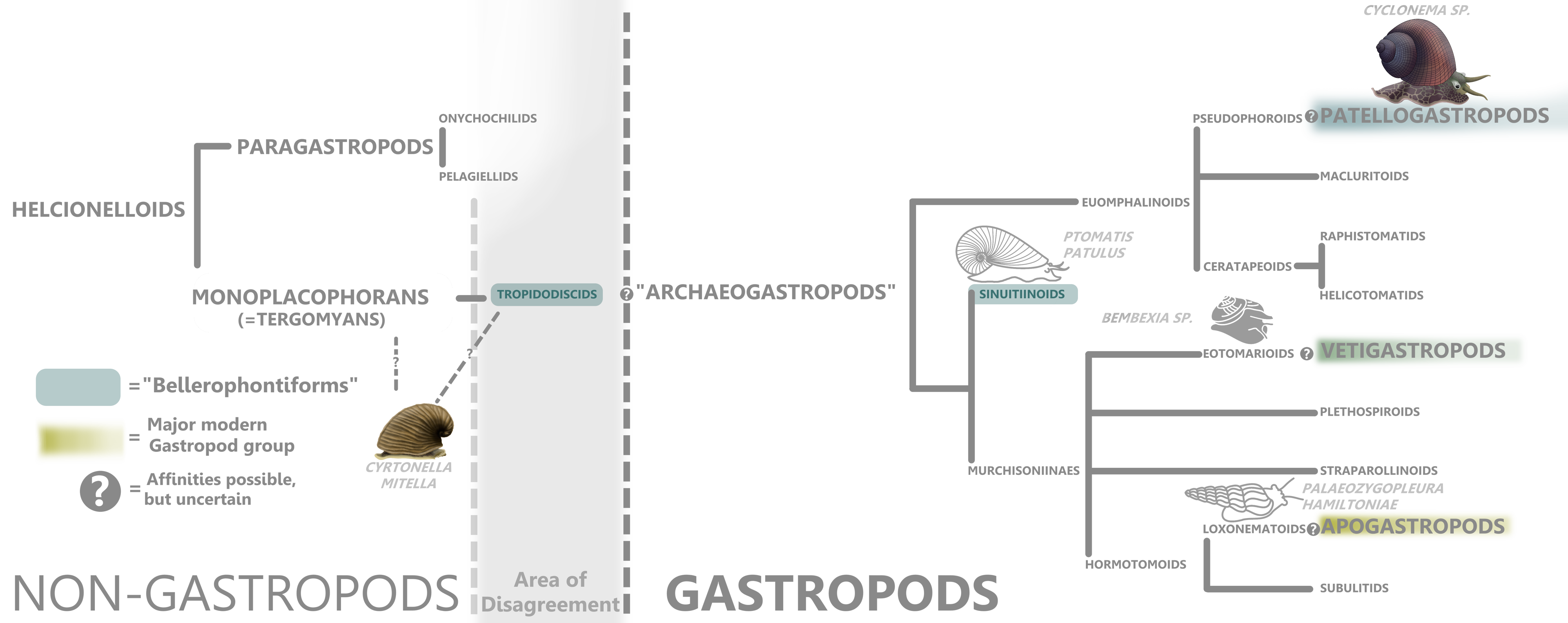
How Cyrtonella’s possible “foliated argonite” fits into this picture is unclear. The majority of paleontologists reference Cyrtonella as a monoplacophoran; however, much of the work done on this genus was done before important stages in the Bellerophont debate. Here, Cyrtonella is deemed a very tentative Monoplacophoran, based on the work of Wagner (2001) and Rollins (1966), who referenced its large prismatic internal shell structure. Ptomatis patulus, another Bellerophont from Seven Stars, exhibits a similar but much finer shell structure than Cyrtonella, but is more Gastropod-like over all and was included in Gastropoda by Wilson (2014) in his book about the Devonian fossils of New York; whether this was on purpose or if it was done out of ignorance is not clear. Ptomatis is considered a Gastropod here, but the classifications of both of these Bellerophonts may be subject to change in the future.
Monoplacophorans at Seven Stars
Monoplacophorans are very rare at Seven Stars, as with other Hamilton group sites. They are represented by only a single species that has been subject to much debate concerning Bellerophontids and their relations to Gastropoda and Monoplacophora. It is thought to have been a grazer, feeding on a food source that is not known to have been preserved.
Cyrtonella mitella
Cyrtonella has a rapidly expanding shell that is unlike all Gastropods at Seven Stars. It has a keel (referred to by Dzik (1980) as an “anal sinus”, because of its positional correlation with the anus) on the posterior edge of the shell, unlike the Gastropods. Its internal molds have a rough surface composed of rather random growth line impressions, while the external surface has a much more orderly arrangement, which still lacks any special longitudinal ornamentation as both the Gastropods Bembexia and Cyclonema have. It can be differentiated from Ptomatis by its rougher texture, smaller maximum size, and lack of a noticeable umbilicus (where all previous whorls are readily visible).

Rarely, foliated argonite is preserved, but is best seen through a pocket microscope or hand lens. In the specimen to the right, it is visible to the naked eye.
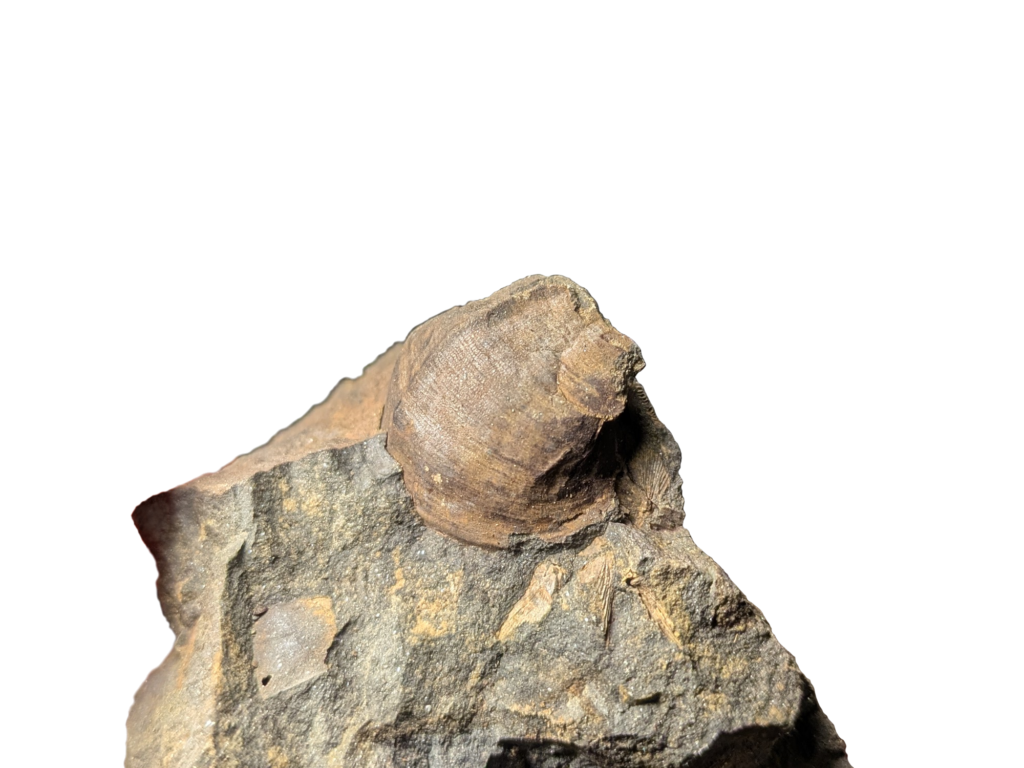
Works cited
(1) Bunje, Paul. “The Monoplacophora.” Ucmp.berkeley.edu, ucmp.berkeley.edu/taxa/inverts/mollusca/monoplacophora.php.
(2) Rollins, Harold B. (1966). Morphological Observations on the Bellerophont Ptomatis Patulus (Hall) (Gastropoda, Bellerophontacea). American Museum of Natural History. pp. 4–6, Accessed 9 Dec. 2023. https://archive.org/details/morphologicalob2242roll/morphologicalob2242roll/page/4/mode/2up
(3) Lindberg, D.R. (2009). Monoplacophorans and the Origin and Relationships of Mollusks. Evo Edu Outreach 2, 191–203. https://doi.org/10.1007/s12052-009-0125-4 https://evolution-outreach.biomedcentral.com/articles/10.1007/s12052-009-0125-4
(4)
Ponder, W.F., Lindberg, D.R., & Ponder, J.M. (2020). Biology and Evolution of the Mollusca, Volume 2 (1st ed.). CRC Press, Chaper 14 – Polyplacophora, Monoplacophora, and Aplacophora https://doi.org/10.1201/9781351115254
Note: This entire Chapter will be open access here until January, 2024. After that, an account will be required to access it here.
(5) Fryda, Jiri & Nützel, Alexander & Wagner, Peter. (2008). Paleozoic Gastropoda. 10.1525/california/9780520250925.003.0010. https://www.researchgate.net/publication/300212099_Paleozoic_Gastropoda
(6) Dzik, J. (1981). Larval development, musculature, and relationships of Sinuitopsis and related Baltic bellerophonts. Norsk Geologisk Tidsskrift, Vol. 61, pp. 111-121. Oslo 1981. ISSN. https://foreninger.uio.no/ngf/ngt/pdfs/NGT_61_2_111-121.pdf
(7) Ebbestad, J. O. R. & Yochelson, E.L. lsostrophic molluscs (Tergomya and Gastropoda) from the Upper Ordovician of Norway.Norsk Geologisk Tidsskrift, Vol. 80, pp. 187-202. Oslo 1999. ISSN 0029-196X. https://foreninger.uio.no/ngf/ngt/pdfs/NGT_80_3_187-202.pdf
(8) Wagner, Peter. (2001). Gastropod phylogenetics: Progress, problems, and implications. Journal of Paleontology. 75. 1128 – 1140. 10.1666/0022-3360(2001)075<1128:GPPPAI>2.0.CO;2. https://www.researchgate.net/publication/215788533_Gastropod_phylogenetics_Progress_problems_and_implications
